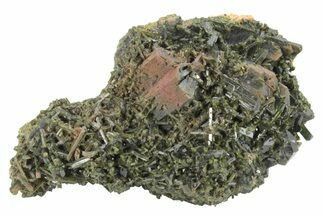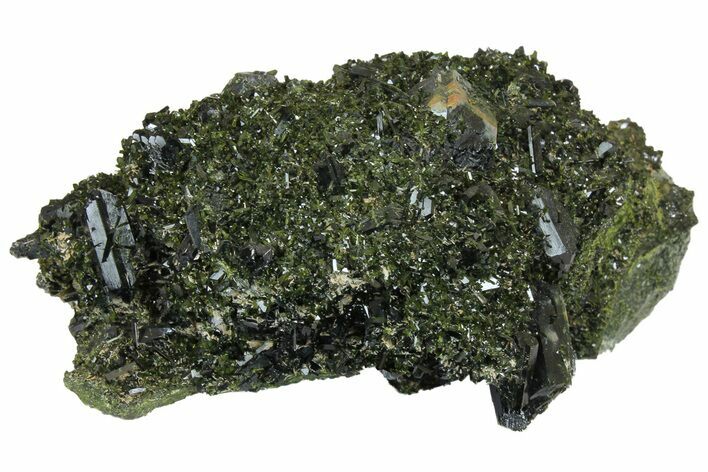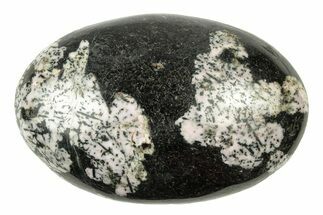This Specimen has been sold.
7.7" Lustrous, Epidote Crystals on Actinolite - Pakistan
This is an incredibly beautiful crystal specimen, with flawless dark green epidote crystals protruding from the pistachio green crystal coated actinolite matrix. Various shapes and sizes of epidote crystals can be found throughout this specimen.
About Epidote
Epidote is a striking and often green mineral known for its complex crystal structure and vitreous luster. It is a calcium aluminum iron silicate that commonly forms in metamorphic rocks, particularly in regions that have undergone low to medium-grade metamorphism. The color of epidote typically ranges from pistachio green to dark green, although it can occasionally appear yellowish-green or even brown due to varying iron content.
Epidote crystals can appear in prismatic, slender forms or as aggregates, and they often exhibit striations along their length. The mineral’s translucent to transparent appearance and high refractive index give it an attractive, glassy shine.
It is commonly associated with minerals such as quartz, feldspar, and garnet, often forming in metamorphic rocks like schist and gneiss. It can also be found in skarn deposits alongside minerals like calcite, diopside, and amphiboles. These associations can provide insights into the geologic history and metamorphic conditions of the region. Epidote is found in locations worldwide, with notable sources including Austria, Norway, Pakistan, and parts of the United States. Collectors prize epidote for its unique green hues and well-formed crystal clusters.
Epidote is a striking and often green mineral known for its complex crystal structure and vitreous luster. It is a calcium aluminum iron silicate that commonly forms in metamorphic rocks, particularly in regions that have undergone low to medium-grade metamorphism. The color of epidote typically ranges from pistachio green to dark green, although it can occasionally appear yellowish-green or even brown due to varying iron content.
Epidote crystals can appear in prismatic, slender forms or as aggregates, and they often exhibit striations along their length. The mineral’s translucent to transparent appearance and high refractive index give it an attractive, glassy shine.
It is commonly associated with minerals such as quartz, feldspar, and garnet, often forming in metamorphic rocks like schist and gneiss. It can also be found in skarn deposits alongside minerals like calcite, diopside, and amphiboles. These associations can provide insights into the geologic history and metamorphic conditions of the region. Epidote is found in locations worldwide, with notable sources including Austria, Norway, Pakistan, and parts of the United States. Collectors prize epidote for its unique green hues and well-formed crystal clusters.
About Actinolite
Actinolite is a green, fibrous to columnar mineral belonging to the amphibole group, commonly found in metamorphic rocks. Its color ranges from pale to dark green, depending on its iron content, with a glassy to silky luster. Actinolite forms long, slender crystals or needle-like fibers, often creating a fibrous or radial texture within rocks. Chemically, it is a calcium magnesium iron silicate with the formula Ca₂(Mg,Fe)₅Si₈O₂₂(OH)₂.
This mineral typically forms during the low to medium-grade metamorphism of magnesium-rich rocks, such as limestone and dolomite, when exposed to moderate heat and pressure. Actinolite is a common component of greenschist and amphibolite facies rocks, often associated with minerals like chlorite, epidote, and albite. Actinolite is also notable for its role in the formation of jade, as it is closely related to nephrite jade, sharing a similar structure and composition.
While actinolite is valued in mineral collections for its striking color and crystal forms, some varieties are fibrous and may pose health risks if inhaled, as they are a type of asbestiform mineral. However, non-fibrous forms are considered safe and are sometimes used in jewelry and ornamental carvings.
Actinolite is a green, fibrous to columnar mineral belonging to the amphibole group, commonly found in metamorphic rocks. Its color ranges from pale to dark green, depending on its iron content, with a glassy to silky luster. Actinolite forms long, slender crystals or needle-like fibers, often creating a fibrous or radial texture within rocks. Chemically, it is a calcium magnesium iron silicate with the formula Ca₂(Mg,Fe)₅Si₈O₂₂(OH)₂.
This mineral typically forms during the low to medium-grade metamorphism of magnesium-rich rocks, such as limestone and dolomite, when exposed to moderate heat and pressure. Actinolite is a common component of greenschist and amphibolite facies rocks, often associated with minerals like chlorite, epidote, and albite. Actinolite is also notable for its role in the formation of jade, as it is closely related to nephrite jade, sharing a similar structure and composition.
While actinolite is valued in mineral collections for its striking color and crystal forms, some varieties are fibrous and may pose health risks if inhaled, as they are a type of asbestiform mineral. However, non-fibrous forms are considered safe and are sometimes used in jewelry and ornamental carvings.
 Reviews
Reviews



















